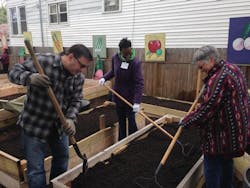The Metropolitan Water Reclamation District of Greater Chicago (MWRD) has formed a new partnership with an urban gardening organization that will foster sustainable farming practices that will soon lead to a bountiful harvest.
The MWRD will provide its exceptional quality (EQ) composted biosolids to be incorporated at 72 community gardens overseen by the ChicaGRO Intergenerational Growing Projects organization. The EQ biosolids are produced during the water treatment process by composting biosolids with woodchips, which makes for an excellent soil enhancer.
On May 14, MWRD Commissioner Kari Steele and other MWRD staff joined the ChicaGRO Intergenerational Growing Project as it turned a vacant South Chicago neighborhood lot into a backyard community garden. Located at 8450 S. Escanaba Ave., the garden will become a source of fresh produce for many residents living in what is considered a food desert.
"Because of partnerships like this, the sustainable practices started at the Metropolitan Water Reclamation District of Greater Chicago can be transferred straight to our very own communities," said Commissioner Steele, who was on hand to kick off the planting day event in South Chicago. "We are happy to play a role in supporting ChicaGRO Intergenerational Growing Projects and look forward to assisting future efforts like this throughout Illinois. We thank them for their commitment to providing urban gardens and cultivating a wealth of nourishing opportunities for so many communities in the Chicago area."
ChicaGRO Intergenerational Growing Projects is an urban vegetable garden initiative that manages 75 community gardens, ranging in size of a third of an acre to 3.5 acres. The gardens stretch beyond the Chicago city limits, extending all the way from Robbins on the south to Evanston on the north. The largest space is at 57th Street and Lafayette Avenue in the Englewood neighborhood, where ChicaGRO grew 15,000 pounds of vegetables last year alone and donated it to the city of Chicago, according to ChicaGRO Executive Director Gregory Bratton. But growing all those crops requires a fair amount of soil. That is why Bratton reached out to Commissioner Steele. Working with the commissioner, MWRD Associate Environmental Soil Scientist Dominic Brose and Managing Civil Engineer Dan Collins helped coordinate the delivery of the product. The compost was used in raised planting beds, while the MWRD also provided recycled woodchips that were placed around the planting beds.
Neighbors and their children also helped prepare the garden and planted carrots, tomatoes, bell pepper, cabbage, sweet potatoes, onions, radishes, corn, sweet peas, okra, and lettuce seeds. They also planted a banana tree grown inside a hoop house. According to Bratton, the garden will help teach area residents about sustainable growing and how to care for and maintain a community backyard garden. Once the vegetables are ready for harvest, Bratton says he will host a day when residents can stop by to help enjoy the fruits of their labor. He also plans to incorporate lessons for healthier lifestyles into each event hosted at the garden to teach residents about the importance of eating nutritious foods. The garden is one of more than 20 ChicaGRO Intergenerational Growing Projects Bratton has developed in South Chicago alone.
By using tree debris as a bulking agent, the composting process raises the temperature of the biosolids and woodchip mixture and destroys pathogens to create an EQ composted biosolids product. The MWRD has a goal of producing 10,000 tons of composted biosolids in 2016. Biosolids are a product of the water treatment process in which organic solids that have settled out during treatment are sent to temperature-controlled digesters where microorganisms break them down in a process similar to composting. At the MWRD, EQ biosolids and EQ composted biosolids are generated by following USEPA-approved processes. In recent years, the biosolids have been made popular by users like farmers, golf course managers, landscapers, municipalities and park districts.
In 2015, Gov. Bruce Rauner signed legislation that amended the Illinois Environmental Protection Act to recognize EQ biosolids as a resource and not a waste. This legislation makes biosolids more accessible and recognized that biosolids are a safe, beneficial and renewable resource that should be used locally. This legislative amendment makes nutrient rich EQ biosolids available to the public for growing food crops and maintaining healthy lawns. To learn more about MWRD's biosolids program, visit www.mwrd.org or call (708) 588-4201, or email [email protected].
Source: MWRD


